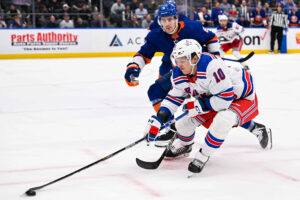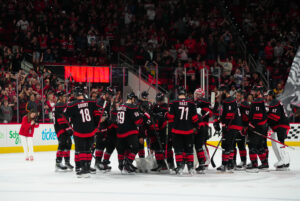This article analyzes footage of Ilya Kovalchuk and his performance on February 10, 2020 against the Arizona Coyotes. You can find a ten-minute reel of his performance here.
What Ilya Kovalchuk Has to Offer
The Player of the Past, and His Current Situation
Ten years ago, Washington Capitals supporters would have been riveted about their team’s acquisition of superstar goal scorer Ilya Kovalchuk. One could reasonably argue that, during the first few years of Alexander Ovechkin‘s career, the Atlanta Thrashers’ Kovalchuk was the league’s next-best goal scorer. Their neck-and-neck race for the 2008 Rocket Richard Trophy was a spectacle to behold; in the season’s first half, Kovalchuk scored 37 goals and 62 points in the first 46 games of the season; meanwhile, in that same span, Ovechkin recorded 35 goals and 57 points in 46 games. Kovalchuk stood side-by-side with that year’s eventual goal-scoring champion for much of the campaign. He was a speedy, dynamic virtuoso whose accuracy as a shooter and one-on-one skills were among the league’s greatest.
Ilya Kovalchuk’s expertise as a sniper remains a core reason for his luster as a National Hockey League player. A five-year absence from the NHL and difficulties with his recent comeback — including the Los Angeles Kings‘ decision in January 2020 to buy out his three-year, $18.75 million contract –, however, have damaged his appeal. With the Kings, he scored 19 goals in 81 games over the course of the past two seasons. His reputation re-surged slightly with his next team, the Montreal Canadiens, at a one-year cost of $700,000. The thirty-six-year-old forward ingratiated himself with the organization and its followers with numerous overtime goals and a sense of style reminiscent, to some extent, of his flashiest days in Atlanta. Despite this positive attention, he scored only six goals and thirteen points in twenty-two games with Montreal.
His recent popularity uptick prompted the Washington Capitals to exchange a 2020 third-round draft choice for Ilya Kovalchuk’s services, a deal that finally unites two of Russia’s most prolific goal scorers since the 2005 NHL lockout. Kovalchuk was reportedly offered a choice between the Capitals and the Boston Bruins. This transaction adds another proficient goal scorer to an already-stacked offensive group. One must wonder, though, the degree to which Kovalchuk will succeed with the Capitals.
The Plight of the Former Superstar Sniper
Kovalchuk’s style of play is heavily dependent on his skating and shooting abilities; his decline since departing from the league in 2013 is well-documented. Some of these skills have naturally eroded with age. Although he remains a potential game-breaker, he is a pending unrestricted free agent. Teams must determine why he failed with the Kings if they are to approach him about a contract.
In this visual analysis, footage was used of Kovalchuk’s performance with Montreal against the Arizona Coyotes on February 10, 2020. In that match, he spent time on a line with Joel Armia; Nick Suzuki and Max Domi joined them.
No Longer a Deadly, Accurate Shooter
From a positional point of view, Ilya Kovalchuk tends to play high in each zone. He prefers to stay within the upper half of the offensive zone. Often, he will hover in the slot area and cruise in the space between the top of both faceoff circles. His one-timer remains a high-velocity threat, and the force behind his wrist shot will be familiar to those who have followed his journey as a scorer. The quality of his shots has diminished since his departure from the NHL, however.
At his peak, Ilya Kovalchuk was a high-percentage shooter whose accuracy and power could overwhelm goaltenders; before leaving the NHL in 2013, his career shooting percentage was 14.1 percent, with a high of 18.4 percent in 2007-08. Since returning last season, he has recorded an average shooting percentage of 10.5 percent. No longer can he fire lasers akin to what long-time viewers are accustomed to seeing from him.
In most instances when a teammate successfully provides him with the puck, he will direct it towards the net with a heavy blast. There are times when he stations himself in the slot in the event that a teammate can force a puck through traffic to him. At other times, he modifies his position to become an available pass recipient. His decision to remain away from the play requires his teammates to be effective forecheckers, as he does not exert consistent effort along the boards. Passes to him are frequently converted into one-timer attempts.
Long-Distance Communication: A Reliance on Lengthy Passes
Cross-ice passes are a significant element of Kovalchuk’s offensive game, and he commonly attempts to generate shots and catch goaltenders off-guard via lateral passing plays. He rarely hesitates to fling the puck to a teammate on the far side of the rink, even when an opponent is within reach to deflect the pass away.
His sense of judgment with the puck is bold and slightly reckless; he takes risks with the puck and is not particularly concerned about giveaways. Wide shots can lead to the puck gliding along the boards at high speed and then out of the zone. Long-distance passes to and from teammates are also a common expectation when he is on the ice. Such plays sometimes lead to high-percentage chances when the opponent is unprepared. Lateral plays of this nature are frequent whenever he enters the offensive zone with the puck.
Comfortable Up High, Tentative Down Low
He remains capable of handling the puck dexterously at his age, and despite losing some of his straight-line speed, Kovalchuk is still quite mobile in tight areas with the puck. He comfortably dictates the direction of his line’s attack whenever he is in the slot and above the faceoff circles.
In spite of his offensive experience and the ease with which he controls offensive situations from the upper half of the offensive zone, the lower half is his least favored section of the rink; the net-front is the exception in this area of the ice. He is a passive forechecker, and among the numerous faults that he possesses, his tendency not to pressure opponents below the opposing goal line is a troublesome concern for puck possession advocates.
Even when the puck is within his reach, he usually does not compete for its retrieval along the boards when an opposing body stands in his path. Instead, he frequently relies on his linemates to battle for possession below the goal line while he waits above it for a pass. Granted, a sly setup to Ilya Kovalchuk in the slot, at the side of the net or in the crease would be a frightening scenario for any opponent. Although he does not battle behind the net, he may cruise between the hash marks and through the crease off the rush in order to capitalize on scoring opportunities around the goal mouth.
Not For Puck Possession Advocates
Ilya Kovalchuk is a low-possession player, and teams should be aware of his risky tendencies. On a line with less-than-stellar forechecking, that trio might spend less time with the puck than one would prefer. Even so, his heavy, and varied, shots generate tremendous pressure for opposing teams. Teammates must pounce on the rebounds for second opportunities and to continue their forecheck. When the puck is along the boards near the half-wall or at the point, he will pinch to keep the play alive, but does not dig for pucks or apply himself aggressively in traffic.
He is a competent player off the rush, but is no longer a consistent, high-impact threat. During even strength defensive zone breakouts, he sometimes gravitates towards the far side of center ice when the puck is lower and on the opposite side of the rink, drifting up into the neutral zone for a long-distance feed. A successful head-man pass to Ilya Kovalchuk allows him to enter the offensive zone quickly; at this point, he can decide to attack the net with a shot or send the puck across to the ice to a teammate. On other occasions — mostly on the powerplay or when the puck is nearby –, he returns to his own zone, gathers the puck and carries it into the neutral zone with as much speed as he can muster. He still possesses enough skill and agility to stick-handle a path into the offensive zone.
Lacking Attention to Detail
One of the most frustrating aspects of Kovalchuk’s game is his lack of attention to detail. His acceleration and high tempo of motion once allowed him to recover much more easily from mistakes. He sometimes skates in loops in the neutral zone whenever the puck is nearby. He does not engage directly with the puck near the boards, and will sometimes perform a flyby. There are also times when he does not offer enough attention to the puck’s position; he will lose his sense of positioning relative to the puck. He will also sometimes be unprepared to receive the puck.
Furthermore, he has been guilty of occasionally executing poor passes. On one occasion in our footage sample, he casually lofted an inaccurate pass back to his defender, forcing the defenceman to race for it against an opposing forechecker. He is an impatient player, always trying to move the play along at a high velocity. He will periodically force passes through closed lanes, for instance; at other times, he may cheat away from a board battle under the assumption that his teammate will regain possession.
Capable Defensively, But Not Consistent
Defensively, he can capably pressure the opposing puck carrier in open ice with adequate stick work. He has demonstrated in the past that he can play reliable defensive hockey. While representing the New Jersey Devils, he garnered praise for his defensive commitments. He also throws occasional body checks. Early in our sample footage, he demonstrated some degree of haste to pressure the opponent. He did not succeed in regaining possession; however, he exhibited a satisfactory level of urgency to force quick decisions from his opponent. As the match continued, his defensive efforts dwindled. His tracking of the puck is average; often, he will leave too much space for the opponent to move the puck before he arrives to pressure.
Conclusion: Kovalchuk Plays an Impatient, Inattentive Game
Ilya Kovalchuk was once seemingly able to score with any line combination. He was prolific in his prime years, carrying his team’s offense with individual displays of talent and panache. Unfortunately, he no longer controls the pace of play nor fires the puck as formidably as he once did. Much of his line’s success requires the forechecking efforts of his linemates; if his team is not careful, his low-possession and impatient style of play will result in turnovers and traded opportunities. He no longer resembles the elite goal scorer of his youth on any more than a surface level. His quick release and puck-handling skills serve to show flashes of that game-breaking talent.
The Washington Capitals have added a player who can pepper the opposing goaltender with shots and keep him busy. Additional puck support must come from other players; the Capitals, thus, must discover the combination that matches Kovalchuk’s strengths and masks his deficiencies.
The Los Angeles Kings are well aware of the consequences of misinterpreting this player’s aptness for their roster. His next suitors will not want to make that same mistake.
Kevin is @CambieKev on Twitter.






